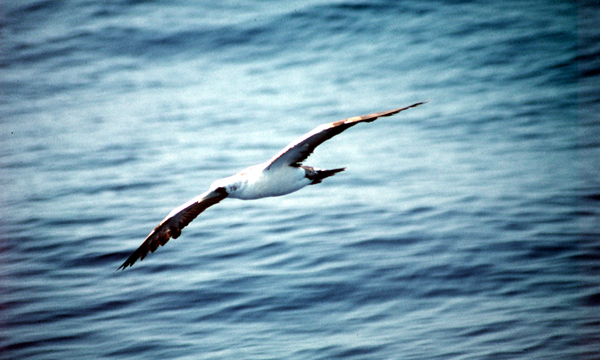|
Masked Booby Sula dactylatra Boba Enmascarada,
|
 |
|
Photo: J. Saliva
|
|
IDENTIFICATION: Largest of the boobies. A white seabird with a yellow bill, black tail, black trailing edge to the wings, and black skin around the bill (the "Mask"). Length: 74-86 cm.; weight: 1,200-2,300 g., females being larger than males. VOICE: Like other boobies, on the breeding grounds, males make a high-pitched whistle, and females a honking sound. HABITAT: Feeds for long periods at sea in warm tropical waters. HABITS: Forages in deeper water than other booby species, and usually hunts alone. It dives from a height of up to 30 meters into the top 3-4 meters of the sea after fish (especially flying fish and halfbeaks (Exocoetidae), jacks (Carangidae)) and some squid. During the breeding season in February-August, just before mating, the male displays to the female by slowly parading around her, displaying his feet, and offering feathers or pebbles. Other mating displays include "sky pointing" (stretching the neck and holding the head straight up for several seconds). The booby nests on the ground on rocky islands, and lays one or two white eggs. Both sexes take turns incubating the eggs over a 38-49 day period. Boobies, like pelicans, do not have a brood patch: an area of exposed skin on the belly that warms the egg during the incubation period. Instead boobies wrap their feet over the eggs to incubate them. As with other booby species, one chick may kill the other chick. Both parents brood and feed the young. Three weeks after hatching, the chicks will walk around the nesting colony, and can fly at about four months of age. STATUS AND CONSERVATION: An uncommon seabird in this part of the Caribbean, but it is found close to its nesting colonies near Culebra and on Monito Island. Only 550-650 pairs are estimated to breed in the Caribbean. RANGE: Occurs throughout the world’s tropical oceans. TAXONOMY: PELECANIFORMES; SULIDAE. Formerly called Blue-faced Booby. Recently taxonomists have split the Masked Booby (Sula dactylatra) into two species: the widespread Masked Booby (Sula dactylatra) and the Nazca Booby (Sula granti) which nests in the Galápagos Islands, Ecuador, and several Pacific islands west of Central America. |
|
 |
|
|
Photo: G. Beaton
|
|
References Anderson, D. J. 1994. Masked Booby (Sula dactylatra). No. 73 in The birds of North America (A. Poole and F. Gill, eds.). Acad. Nat. Sci., Philadelphia, PA, and Am. Ornithol. Union, Washington, D.C. Bent, A.C. 1922. Life histories of North American petrels and pelicans and their allies. Smithsonian Instit. U.S. National Museum Bull. 121. (Reprinted by Dover Press, 1964). Burger, A. E. and A. D. Lawrence. 2000. Seabird monitoring techniques. Pp. 148-173 in Status and conservation of West Indian seabirds (E. A. Schreiber and D. S. Lee, eds.). Soc. Carib. Ornith., Special Pub. No. 1. Dammann, A.E. and D.W. Nellis. 1992. A natural history atlas to the cays of the U.S. Virgin Islands. Pineapple Press, Sarasota, FL. del Hoyo, J., A. Elliott, and J. Sargatal, eds. 1992. Handbook of Birds of the World, Vol. 1, Ostrich to ducks. Lynx Edicions, Barcelona.
Harrison, P. 1983. Seabirds: an identification guide. Houghton Mifflin, Boston. Harrison, P. 1987. A field guide to seabirds of the world. Stephen Greene Press, Lexington, MA. Moskoff, W. 1998. Death in the nest: siblicide among birds. Birding 30(6):511-515. Norton, R.L. 1988. The density and relative abundance of Pelecaniformes on the Eastern Puerto Rico Bank in December 1982. Carib. J. Sci. 24:28-31. Pitman, R. L. and J. R. Jehl, Jr. 1998. Geographic variation and reassessment of species limits in the "Masked" Boobies of the eastern Pacific Ocean. Wilson Bull. 110:155-170. Raffaele, H.A. 1989. A guide to the birds of Puerto Rico and the Virgin Islands. Princeton. Raffaele, H.A. 1989. Una guía a las aves de Puerto Rico y las Islas Vírgenes. Publishing Resources, Inc., Santurce, PR. Raffaele, H.A., J.W. Wiley, O.H. Garrido, A.R. Keith, and J.I. Raffaele. 1998. Guide to the birds of the West Indies. Princeton. Schreiber, E. A. 2000. Status of Red-footed, Brown and Masked Boobies in the West Indies. Pp. 46-57 in Status and conservation of West Indian seabirds (E. A. Schreiber and D. S. Lee, eds.). Soc. Carib. Ornith., Special Pub. No. 1. Schreiber, E. A. and D. S. Lee. 2000. West Indian seabirds: a disappearing natural resource. Pp. 1-10 in Status and conservation of West Indian seabirds (E. A. Schreiber and D. S. Lee, eds.). Soc. Carib. Ornith., Special Pub. No. 1. Schreiber, E. A. 2000. Action plan for conservation of West Indian seabirds. Pp. 182-191 in Status and conservation of West Indian seabirds (E. A. Schreiber and D. S. Lee, eds.). Soc. Carib. Ornith., Special Pub. No. 1. Tershy, B. R., D. Breese, and D. A. Croll. 2000. Insurance eggs versus additional eggs: do Brown Boobies practice obligate siblicide? Auk 117(3):817-820. Wiley, J. W. 2000. A bibliography of seabirds in the West Indies. Pp. 192-225 in Status and conservation of West Indian seabirds (E. A. Schreiber and D. S. Lee, eds.). Soc. Carib. Ornith., Special Pub. No. 1. Next related species in taxonomic order Previous related species in taxonomic order |
|